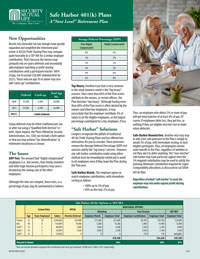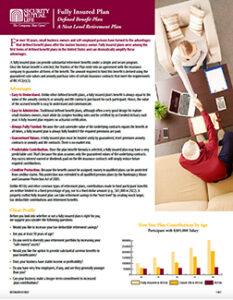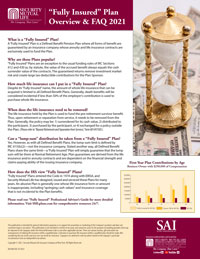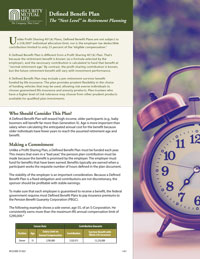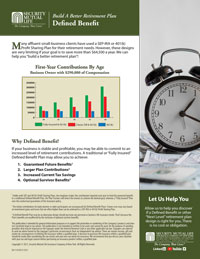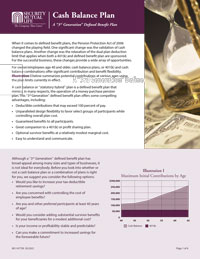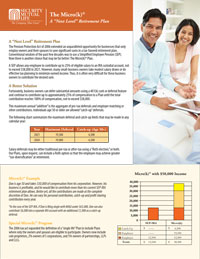
Do you wish to allow participants to deposit a portion of their pay into the plan in the form of 401(k) elective deferrals?

Which of these statements best describes your goals for this plan?

Traditional Profit Sharing Plans
Currently the Profit Sharing plan is one the most popular retirement plans. A profit sharing plan offers the greatest flexibility and variety of options, including the ability to add a 401(k) salary deferral provision ( i.e., a 401(k) Plan).
In a profit sharing plan, the employer may make tax-deductible contributions each year for their employees (owners are also considered employees). Contributions to profit sharing plans are not required from year to year, and the amount of the contribution is generally at the discretion of the employer. Each participant shares in the allocation of the contribution based on a formula that is defined by the plan’s pre-established rules (the plan document). A participant’s share of the contribution is based on his or her salary. The plan may also take into account other factors, such as the age of the participant, when allocating the contribution.
Profit sharing plans have an annual per-participant contribution limit of $58,000. The amount of the contribution that is tax-deductible for the employer is limited to 25% of the gross annual salaries of all plan participants.

New Comparability Profit Sharing Plans
This is a Profit Sharing Plan that has pre-established allocation groups written into the plan document (such as Owners, Management, and All Others). As in all profit sharing plans, the contribution each year is entirely discretionary.
The New Comparability method gives even further control to the plan sponsor by allowing different contribution percentages to be given to each group as long as complex non-discrimination tests are passed. For example, 20% of pay to the owners group, 8% to the management group, and 5% to all others. This type of plan gives the greatest amount of control to the employer.
Who is a New Comparability plan right for?
- Businesses of any size seeking the greatest control over the allocation of employer contributions.
- Businesses of small to moderate size (such as Doctor or Dentist Practices) where greater contributions for a select group are desired.

Which of these statements best describes your goals for this plan?

Safe Harbor 401(k) Plans
A traditional 401(k) plan is generally not favorable to “highly compensated employees” (owners, their immediate family members, and those who earned more than $125,000 in 2019 and $130,000 in 2020). The employee deferrals usually require testing to ensure the plan is non-discriminatory. This testing links the deferrals of those who are considered highly compensated employees with those who are not. In most cases this testing severely limits the amounts the highly compensated employees may defer.
The solution to the problem is called a “Safe Harbor." By promising a certain guaranteed employer contribution each year to the plan participants, the plan is exempt from testing employee deferrals. This exemption allows all participants the option to defer the maximum allowable amount.
The guaranteed employer contribution is 3% of pay or a match of up to 4% of pay.
Who is a Safe Harbor 401(k) plan right for?
- Small-to medium-sized businesses where the owners or management wish to save for retirement but are concerned about the cost effectiveness of the plan.
- Businesses whose “highly compensated employees” wish to make substantial 401(k) deferrals.
Another example of a Safe Harbor 401(k) is the “DASH” plan. This combines the benefits of the Safe Harbor 401(k) feature with a New Comparability Profit Sharing Plan.
Traditional 401(k) Plans
In its traditional form, a 401(k) plan is a Profit Sharing plan that also allows employees to deposit a portion of their pay into the plan in the form of salary deferrals. These deferrals are deposited on a pre-tax basis, and income taxes are paid only when the monies are withdrawn from the plan. 401(k) plans are attractive to younger employees and serve as an effective recruiting tool. In a deferral-only 401(k) plan, the maximum annual contribution is $19,500 ($26,000 if the participant is age 50 or older by plan year end).
In addition to Employer Profit Sharing contributions, 401(k) plans may also allow for an employer match on employee salary deferrals. When this is done the plan offers not only employee pre-tax contributions but also employer tax-deductible contributions. In a 401(k) plan with employer contributions, the maximum total annual contribution an individual participant may receive is $58,000 ($64,500 if the participant is age 50 or older by plan year end).
Who is a traditional 401(k) plan right for?
401(k) plans are extremely flexible and efficient retirement plans. They have favorable applications for a wide spectrum of businesses. A 401(k) plans is appropriate for:
- Businesses seeking to provide a cost-effective employee benefit and recruitment tool.
- Businesses that want employees to share in the cost of funding their retirement savings.
Traditional 401(k) plans are generally not favorable to “highly compensated employees”. For the 2021 plan year, an employee who earns more than $130,000 in 2020 is an HCE. If this is an important consideration, then your company may be best suited for a Safe Harbor 401(k) or a “DASH” 401(k).

DASH 401(k)
A Double Advantage Safe Harbor or “DASH” plan combines the benefits of a Safe Harbor 401(k) with a New Comparability Profit Sharing Plan.
The “DASH” plan allows all participants to make the maximum allowable deferral each year. The plan also allows the employer to make targeted tax-deductible profit sharing contributions.
This is the plan of choice for plan sponsors who wish to maximize the individual contributions to a select group (owners, management, etc.) and minimize employee cost.
Who is the “DASH” plan right for?
- Small-to medium-sized businesses where the owners or management wish to maximize their retirement savings but are concerned about the cost effectiveness of the plan.
- Businesses that wish to reward specific classes of employees (i.e., management).
Employers should intend a qualified retirement plan to be permanent when established. Retirement plans also have ongoing reporting and administrative costs. We do not recommend establishing a plan for a one-time tax savings.
Traditional Profit Sharing Plan
Currently the Profit Sharing plan is one the most popular retirement plans. A profit sharing plan offers the greatest flexibility and variety of options, including the ability to add a 401(k) salary deferral provision ( i.e., a 401(k) Plan).
In a profit sharing plan, the employer may make tax-deductible contributions each year for their employees (owners are also considered employees). Contributions to profit sharing plans are not required from year to year, and the amount of the contribution is generally at the discretion of the employer. Each participant shares in the allocation of the contribution based on a formula that is defined by the plan’s pre-established rules (the plan document). A participant’s share of the contribution is based on his or her salary. The plan may also take into account other factors, such as the age of the participant, when allocating the contribution.
Profit sharing plans have an annual per-participant contribution limit of $58,000. The amount of the contribution that is tax-deductible for the employer is limited to 25% of the gross annual salaries of all plan participants.
In the past, a plan called a Money Purchase Plan was the vehicle used when a guaranteed contribution was desired. For example: 5% of annual salary each year. The formula for determining the contribution was defined in the plan document. Once a year had started and participants had met the requirements to receive an allocation, the employer was required to make the contributions.
New IRS rules have increased the tax-deductible limits to traditional profit sharing plans to now be the same 25% of gross annual salaries that previously was available only under a money purchase plan.
Now a traditional profit sharing plan can be designed to accomplish the same goals. But because contributions would not be totally discretionary, these plans are much less flexible and therefore much less attractive to most plan sponsors. Currently their application is generally limited to those employers with a need to guarantee a specific contribution amount. An example of this would be an employer who has a collective bargaining agreement with a union that guarantees the union employees a specific retirement amount each year.
However, a profit sharing can also be designed to also allow for discretionary contributions along side of this guaranteed contribution. If the guaranteed level is set at less than 25% of eligible compensation, a discretionary contribution could be available.
The individual annual limits to a Traditional Profit Sharing Plan is $58,000. The amount of contribution that is tax-deductible for the employer is limited to 25% of the gross annual salaries of all plan participants.

Which of these statements best describes your goals for this plan?
Fully Insured Plans
A Fully Insured plan is a defined benefit plan, and in most respects they are the same. The major difference between the two is that a Fully Insured plan is required to have all plan assets invested with an insurance company. The returns on these investments are guaranteed. However the returns are generally lower than the return one generally can expect from other investment types.
What are some of the benefits of a Fully Insured plan?
- Because the investment results are assumed to be lower, these plans generate very large deductible contributions.
- No market risk; the investment results are guaranteed.*
- Administrative cost savings because an actuarial certification is not required.
Who is a Fully Insured plan right for?
- Small businesses seeking large tax-deductions who have few (if any) employees other than the owners.
- Businesses that have stable and predictable income.
- Owners that are risk averse and seek guaranteed benefits without market volatility.
Defined Benefit Plans
Instead of determining an annual contribution each year, a defined benefit plan promises to pay a specific benefit at retirement. For example: 50% of average compensation for life.
Each year the amount of the contribution is determined based on the amount that is necessary to pay the promised retirement benefits. The employer is generally required to make contributions to a defined benefit plan each year.
- The maximum annual benefit a participant may receive at retirement is $230,000.
- The employer may tax-deduct the entire required contribution each year.
Who is a defined benefit plan right for?
- Small businesses seeking large tax deductions.
- Businesses seeking to attract and reward long-term employees.

Cash Balance Plans
Cash balance plans are swiftly becoming the plan of choice for small businesses that desire large deductions and benefits following the passage of the Pension Protection Act '06. These plans are often paired with a Safe Harbor 401(k) plan to create a retirement plan program that offers the best of both the defined contribution and defined benefit worlds.
A Cash Balance plan, termed a "statutory hybrid" plan, is a defined benefit plan that mimics the operation of a Money Purchase pension plan. Our cash balance program offers:
- Deductible contributions that may exceed 100% of pay
- Design flexibility
- Guaranteed benefits to participants
- Easy to understand and communicate
Unlike Fully Insured plans or traditional defined benefit plans, a cash balance plan may be designed to better control the cost of the rank-and-file employee benefits. The operative engine that makes this work is often referred to as New Comparability and is very similar to the nondiscrimination testing criteria of profit sharing plans that use this feature.
Which of these statements best describes your contribution goals?
Micro(K)® Plans
A Micro(k)® plan is similar to a traditional 401(k) plan. A Micro(k)® allows participants to deposit a portion of their pay into the plan in the form of salary deferrals. These deferrals are deposited on a pre-tax basis, and income taxes are only paid when the monies are withdrawn from the plan. In a deferral only Micro(k)® plan, the maximum annual contribution is $19,500 ($26,000 if the participant is age 50 or older by plan year end).
Micro(k)® plans may also allow for employer contributions, such as profit sharing or an employer match on salary deferrals. In a Micro(k)® plan with employer contributions, the maximum total annual contribution an individual participant may receive is $58,000 ($64,500 if the participant is age 50 or older by plan year end).
A Micro(k)® plan differs from a traditional 401(k) in that it applies solely to businesses without eligible common-law employees. The only participants in a Micro(k)® plan may be owners, partners and their spouses. Some of the many benefits include:
- Tax savings
- Cost-effective administration and setup
- Flexible investment options
- Loans may be taken from plan accounts
- No required contributions

Defined Benefit Plans
Instead of determining an annual contribution each year, a defined benefit plan promises to pay a specific benefit at retirement. For example: 50% of average compensation for life.
Each year the amount of the contribution is determined based on the amount that is necessary to pay the promised retirement benefits. The employer is generally required to make contributions to a defined benefit plan each year.
- The maximum annual benefit a participant may receive at retirement is $230,000.
- The employer may tax-deduct the entire required contribution each year.
Who is a defined benefit plan right for?
- Small businesses seeking large tax deductions.
- Businesses seeking to attract and reward long-term employees.


